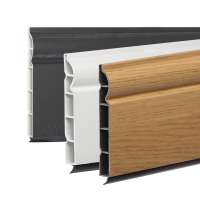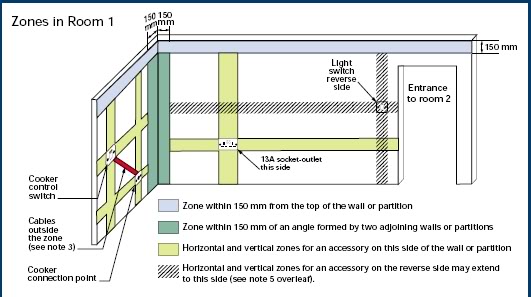-
 Looking for a smarter way to manage your heating this winter? We’ve been testing the new Aqara Radiator Thermostat W600 to see how quiet, accurate and easy it is to use around the home. Click here read our review.
Looking for a smarter way to manage your heating this winter? We’ve been testing the new Aqara Radiator Thermostat W600 to see how quiet, accurate and easy it is to use around the home. Click here read our review.
You are using an out of date browser. It may not display this or other websites correctly.
You should upgrade or use an alternative browser.
You should upgrade or use an alternative browser.
1 new double socket on ring
- Thread starter lmhud
- Start date
View attachment 211681 View attachment 211682 View attachment 211683 View attachment 211685 Thanks for help guys. Went with version 2. Then ran spur from the extended ring.
All working.
Photo 1. Ring
2 version
3 extended ring
4 spur.
- Joined
- 17 Aug 2010
- Messages
- 2,888
- Reaction score
- 506
- Country

It doesn't look like the cables are all being run in safe zones. You may wish to read up on that.
Thanks. They will be going inder the floorboards, is that not okay ?It doesn't look like the cables are all being run in safe zones. You may wish to read up on that.
- Joined
- 17 Aug 2010
- Messages
- 2,888
- Reaction score
- 506
- Country

Yeah, that's ok.
Thanks for your help and advice. It’s appreciated.Yeah, that's ok.
You are confused because the second paragraph is wrong (though the first is right).View attachment 211638
I’m confused by that as it says this
It is also impossible to overload the ring if the 2 spurs are not connected near the end of the ring.
- Joined
- 22 Jan 2007
- Messages
- 22,978
- Reaction score
- 3,067
- Country

It is also impossible to overload the ring if the 2 spurs are not connected near the end of the ring.
And Banallsheds has said that exact same thing many times on the Screwfix forums. You stole that idea from him.....
- Joined
- 27 Jan 2008
- Messages
- 27,406
- Reaction score
- 3,309
- Location
- Llanfair Caereinion, Nr Welshpool
- Country

I have questioned how this
 is permitted but putting cables behind skirting boards is not?
is permitted but putting cables behind skirting boards is not?
 Safe zones does not include behind skirting, See here.
Safe zones does not include behind skirting, See here.
As to loading on a ring final it would depend on the current rating of the cable, but if 20 amp and drawing 32 amp on 106 meters, then to be within want 20 amp and 12 amp split so first 39 meters from consumer unit could be over loaded, however it is unlikely to be over loaded for long, or by any great amount and to get that load would need at least 3 socket outlets or an unfused spur drawing need maximum, so it is recommended that any equipment over 2 kW which is not portable has a dedicated supply, as portable appliances are unlikely to cause an over load for long enough to cause a problem.
There seems to be two exceptions to being portable and drawing maximum for an extended time, the blow up hot tub, and the electric car. The built in oven, washing machine and tumble drier may take the load for an extended time, as with the immersion heater, but they are not portable as over the weight limit and not on wheels, and fixed in some way in the main so if the recommendations are followed should have a dedicated supply.
One would not expect a load of full 13 amp on multi-sockets in a bed room, however the problem arises where the bedroom is used for some thing else, in my old house we use to keep cloths and sheets etc up stairs in the wardrobes or airing cupboard, and would get undressed and dressed up stairs, so had tumble drier up stairs, never put washing machine up there, but can see why some one would, I have never really worked out how washing cloths and cooking food go together? this house we have an utility room, however the point is people can re-assign a bedroom as a laundry room, so because all you will plug in now is a bed side lamp, that does not mean that will still be case in 20 years.

As to loading on a ring final it would depend on the current rating of the cable, but if 20 amp and drawing 32 amp on 106 meters, then to be within want 20 amp and 12 amp split so first 39 meters from consumer unit could be over loaded, however it is unlikely to be over loaded for long, or by any great amount and to get that load would need at least 3 socket outlets or an unfused spur drawing need maximum, so it is recommended that any equipment over 2 kW which is not portable has a dedicated supply, as portable appliances are unlikely to cause an over load for long enough to cause a problem.
There seems to be two exceptions to being portable and drawing maximum for an extended time, the blow up hot tub, and the electric car. The built in oven, washing machine and tumble drier may take the load for an extended time, as with the immersion heater, but they are not portable as over the weight limit and not on wheels, and fixed in some way in the main so if the recommendations are followed should have a dedicated supply.
One would not expect a load of full 13 amp on multi-sockets in a bed room, however the problem arises where the bedroom is used for some thing else, in my old house we use to keep cloths and sheets etc up stairs in the wardrobes or airing cupboard, and would get undressed and dressed up stairs, so had tumble drier up stairs, never put washing machine up there, but can see why some one would, I have never really worked out how washing cloths and cooking food go together? this house we have an utility room, however the point is people can re-assign a bedroom as a laundry room, so because all you will plug in now is a bed side lamp, that does not mean that will still be case in 20 years.
Yeah, those have always struck me as a bit dubiousI have questioned how thisis permitted but putting cables behind skirting boards is not?
If something is obviously conduit or trunking, then I think it's fair enough not to regard the cable as concealed, but when the conduit or trunking is deliberately designed not to look like conduit or trunking then this seems far more questionable tome.
- Joined
- 17 Aug 2010
- Messages
- 2,888
- Reaction score
- 506
- Country

I have loads of this and similar, and I promise you that nobody is going to decide to put a nail into it.
There are many things that are legal to buy but not legal to use.I have questioned how thisis permitted but putting cables behind skirting boards is not?
e.g. Cars that can exceed 70 MPH.
Power line adapters that cause harmful interference,
Just to mention 2 extremes.
Back to the plastic skirting it is only mains cables that are not permitted. HDMI, CAT5, aerial, satellite are all permitted as far as I know.
- Joined
- 17 Aug 2010
- Messages
- 2,888
- Reaction score
- 506
- Country

Trunking is a recognised way to distribute wires. There is no distinction made about the kind of wiring it may contain. The only rule is physical separation of different bands.Back to the plastic skirting it is only mains cables that are not permitted. HDMI, CAT5, aerial, satellite are all permitted as far as I know.
And Banallsheds has said that exact same thing many times on the Screwfix forums. You stole that idea from him.....
I’ve added this to the strange coincidence thread...
DIYnot Local
Staff member
If you need to find a tradesperson to get your job done, please try our local search below, or if you are doing it yourself you can find suppliers local to you.
Select the supplier or trade you require, enter your location to begin your search.
Please select a service and enter a location to continue...
Are you a trade or supplier? You can create your listing free at DIYnot Local
Similar threads
- Replies
- 41
- Views
- 11K




